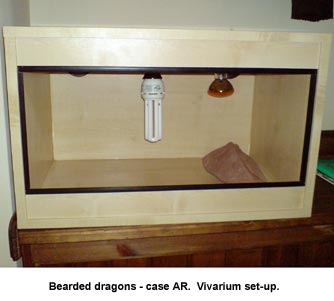|
|
This
is one case from a series of reports compiled as part
of an investigation into photo-kerato-conjunctivitis,
possibly occurring as a result of excessive low-wavelength
UVB radiation under certain brands of fluorescent
UVB lamp.
Please
do not view this one case without reference to the
whole report of which it is a part.
|
Case
History : AR
(UK) - Bearded dragon hatchlings
(Pogona vitticeps)
Two
healthy four-week-old bearded dragon hatchlings were obtained
from a breeder on August 31st 2007. They were placed in
a brand new vivarium, size 24 in. by 15 in. by 15 in., fitted
with a basking lamp and a new ZooMed Reptisun 10.0 lamp,
all supplied together as a set by a local reptile shop,
along with an artificial basking rock. (Figure 1.) When
set up, the Reptisun 10.0 lamp was 6 inches to the side
of the basking rock and the bottom of the lamp was 4 inches
from the vivarium floor.
 An
instruction leaflet was in the box with the Reptisun lamp,
and the new owner noticed the recommendations, but found
the vivarium was too small to enable the lamp to be positioned
at the suggested minimum distance. An
instruction leaflet was in the box with the Reptisun lamp,
and the new owner noticed the recommendations, but found
the vivarium was too small to enable the lamp to be positioned
at the suggested minimum distance.
In
the shop, however, he had seen that there were compact lamps
set up in most of their small vivaria, in exactly the same
way; and since he had been sold all the equipment together,
he assumed this set-up must be suitable.
After
2 to 3 days both babies began to look ill; they had developed
swollen eyelids, stopped eating and slept more or less constantly.
Their owner did not connect their symptoms with the UVB
lamp.
By
4th September, he was bathing their eyes regularly, and
trying to force-feed them.
On
6th September one of them died, and the other was walking
around as if blind, with its eyes shut. This baby, too,
died on 9th September. On that day, the owner found a link
to the UV Guide UK website where there was a description
of the connection between certain UVB compact lamps and
photo-kerato-conjunctivitis. It was only then that he realised
what the problem was, but by then it was too late.
|


















 An
instruction leaflet was in the box with the Reptisun lamp,
and the new owner noticed the recommendations, but found
the vivarium was too small to enable the lamp to be positioned
at the suggested minimum distance.
An
instruction leaflet was in the box with the Reptisun lamp,
and the new owner noticed the recommendations, but found
the vivarium was too small to enable the lamp to be positioned
at the suggested minimum distance.